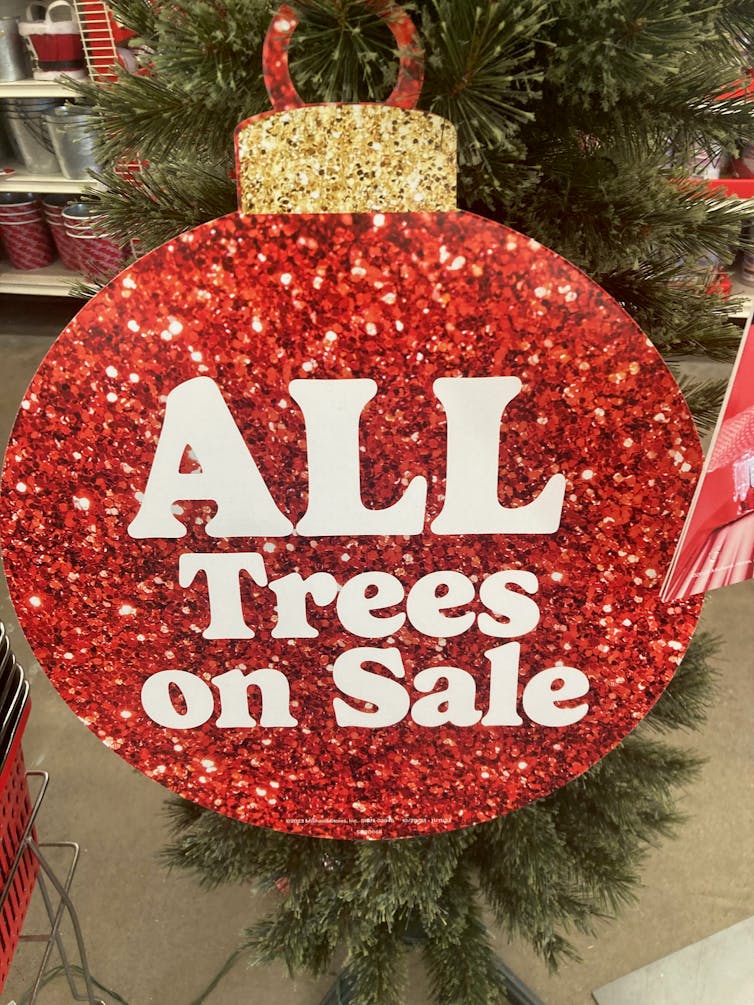News
Oh, Christmas tree: The economics of the US holiday tree industry
Published: December 6, 2023 2:41pm EST
Peace, joy and profit margins: Retailers sell Christmas trees at a markup of up to 500%. Iuliia Bondar/Getty Images Plus
Christmas today is a big business, and one part of that is the multibillion-dollar business of selling Christmas trees. The U.S. Christmas tree industry is so large, it even has two dueling trade groups: one that supports natural trees and the other, artificial.
We are two business school professors whose students asked us to explain the economic impact of the winter holidays. In the holiday spirit of sharing, we’re giving you some facts to discuss while trimming your tree.
Where to buy a natural Christmas tree – or chop one down yourself
There are three different ways to get a natural Christmas tree.
First, you can go into a national forest and chop down your own. Relatively few Americans do this, even though a permit costs $10 or less, because government rules require that the tree you chop must be more than 200 feet from any road, campground or recreation area. Since dragging a tree destroys its branches and needles, the 200-foot rule means that large, heavy trees have to be carried a fair distance through often snowy woods.
Your second option is to buy or chop down a tree at a local Christmas tree farm. Christmas tree farms got a big promotional boost when Taylor Swift revealed she grew up on one, but she’s hardly alone: There are nearly 3,000 Christmas tree farms across the U.S., according to the Department of Agriculture’s most recent figures. These farms sell around 12 million trees a year.
While being a Christmas tree farmer sounds idyllic, it isn’t very profitable, since Christmas trees take over a decade to grow large enough to sell. Long lead times combined with changing and unpredictable weather have pushed many of these farms out of business. Almost 500 U.S. Christmas tree farms shuttered between 2014 and 2019, the USDA found.
The third way to buy a tree is from a local retailer that imports trees. In 2022, the U.S. imported almost 3 million natural Christmas trees, primarily from Canada. Imports have been growing steadily: In 2014, the U.S. imported only half as many trees.
Together, this means that in 2022, roughly 15 million locally grown or imported natural trees were sold in the country.
Some people like to buy their trees from a nonprofit, like the Boy Scouts. These fundraisers are also supplied from local Christmas tree farms or imports.
An artificial tree’s journey from China to your living room
Artificial trees are popular with people who don’t like the mess and fuss of natural trees. Replica trees primarily come from China, and most are made in the Chinese city of Yiwu. The U.S. imported over 20 million artificial trees in 2022 alone.
And they’re becoming increasingly common. In 2014, the U.S. imported 11 million artificial trees and sold almost 22 million natural trees. This means that back in 2014, almost two real trees were purchased for every artificial one. A decade later, natural tree sales had fallen to around 15 million, but over 20 million artificial trees were imported.
One result of the shift to replica trees is a reduction in house fires. Natural trees that aren’t watered dry out and sometimes catch on fire. In 1980, the U.S. saw about 850 Christmas tree fires that caused 80 people to be injured. Four decades later, the number of annual fires fell to 180, with only eight injuries.

RELATED NEWS
- O+ Tower Project Showcases Our Production Prowess 2025-02-20
- Guangdong Aluminum Association and Moscow University Business School visited Gua 2024-12-12
- Guangdong Aluminium Association International Trade Co., Ltd. signed an overseas 2024-11-21
- Guangdong Aluminum Association International Trade Co., Ltd. Participates in the 2024-11-15
- Simplified Approach to Spandrel Area Treatment in Curtain Wall Glazing 2024-10-25
CATEGORIES
LATEST NEWS
CONTACT US
Contact: Manager:Miss Jasmien
Phone: +8618825429836
E-mail: info@gdaa-cn.com
Whatsapp:+8618825429836
Add: Headquarter:No.8,Yixian Road,GDAA Mansion,Guangfo Zhicheng, Dali Town,Foshan,Guangdong.China
